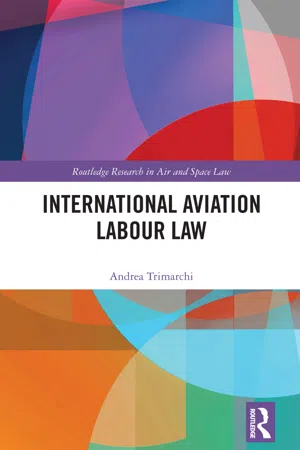
- 192 pages
- English
- ePUB (mobile friendly)
- Available on iOS & Android
International Aviation Labour Law
About This Book
International Aviation Labour Law explores the status quo of the international regulation of labour and employment within the air transport industry and provides a detailed analysis of the regulatory endeavours undertaken at the international, European and domestic level to harmonise aviation labour regulations and ensure adequate labour standards for aircrew members.
Offering an original insight into the regulation of labour in the aviation sector and airline industry, it analyses regulatory endeavours undertaken at the international, European and domestic level, exploring the main challenges arising from non-uniform and fragmented regulation of labour standards in the air transport sector. In particular, it investigates whether aviation labour regulations are sufficiently harmonised at an international level to ensure adequate labour standards for aircrew members. Key concerns relating to aviation labour are dealt with from a regulatory and practical perspective, and the current normative gaps are examined in view of potential future regulatory trends and solutions via a thorough analysis of the applicable legislation, landmark court decisions and the use of practical examples, to provide an overview of the various nuances of the topic.
The book identifies and explore the main implications and repercussions of regulatory asymmetry and highlights the critical role of labour for air transport and how discrepancies in labour regulation may affect the practice of flying and the essence of aviation safety. It emphasises a strong need for international regulatory coordination and is a key reference for a varied audience of students, academics, professionals and rule-makers involved in the air transport arena and for all those who have an interest in the regulation of labour and employment in aviation.
Frequently asked questions
1 The Law of Labour
1. International Labour Law
1.1 Historical Background
1.2 The Declaration of Philadelphia 1944 and the Establishment of the International Labour Organization
- labour is not a commodity;
- freedom of expression and of association;
- war on poverty; and
- principle of ‘tripartism’.8
1.3 The Declaration on the Fundamentals Principles and Rights at Work of 1998 and the Pillars of International Labour Law
- freedom of association and effective recognition of the right to collective bargaining;
- the elimination of all forms of force or compulsory labour;
- the effective abolition of child labour; and
- the elimination of discrimination in respect of employment and occupation.
1.4 The Structure of the International Labour Organization
- A General Conference, which comprises representatives of all Members. This goes under the denomination of International Labour Conference. The Conference meets once every year at the
ILO’s headquarters, in Geneva, Switzerland, to set the main policies, work programmes and the budget of the Organisation. The Conference also elects the Governing Body of the ILO. Also known as the ‘International Labour Parliament’, it adopts Conventions and Recommendations, thereby exercising the Organisation’s rule-making function. Representation within the Conference is ensured through delegations, which “shall be composed of four representatives of each of the Members, of whom two shall be Government delegates and the two others shall be delegates representing respectively the employers and the workpeople …”.20 Notably, each delegate has the right to vote individually and independently.21 - The Governing Body is the secretariat – or the government – of the
ILO. It has extensive powers, including the authority to decide on the Organisation’s broad policies, to decide on the agenda of the International Labour Conference, as well as to elect the Director General. The Governing Body’s internal structure shows some significant similarities with that of, among others, the ICAO Council,22 with ten of the represented gov...
Table of contents
- Cover
- Half Title
- Series
- Title
- Copyright
- Dedication
- Contents
- Biography
- Abbreviations
- Acknowledgements
- Preface
- Introduction
- 1 The Law of Labour
- 2 The Regulation of Labour and Employment under International Air Law
- 3 The Regulation of Labour and Employment under European Air Law
- 4 The Impact of Fragmented Labour Standards in Air Transport
- 5 Aviation Labour Law as a Self-Standing Branch of Law
- Conclusions
- Appendix: Excerpt of Relevant Legal Texts
- List of Sources
- Index